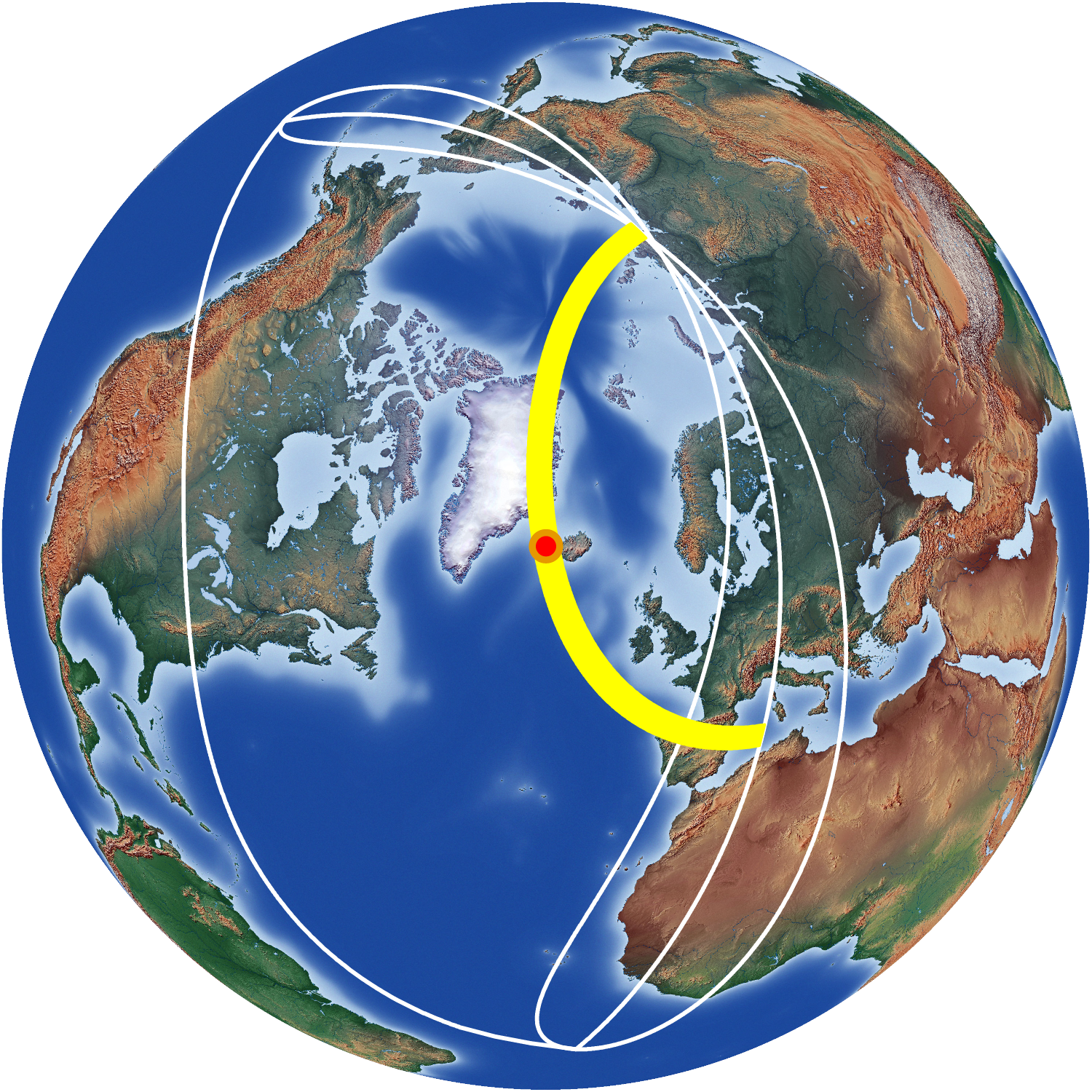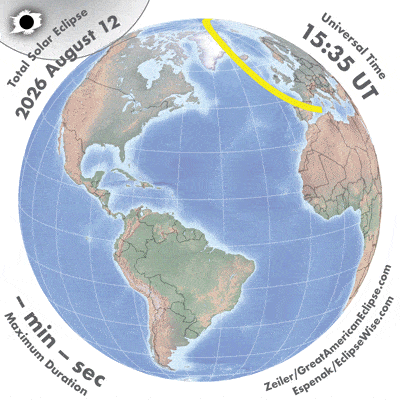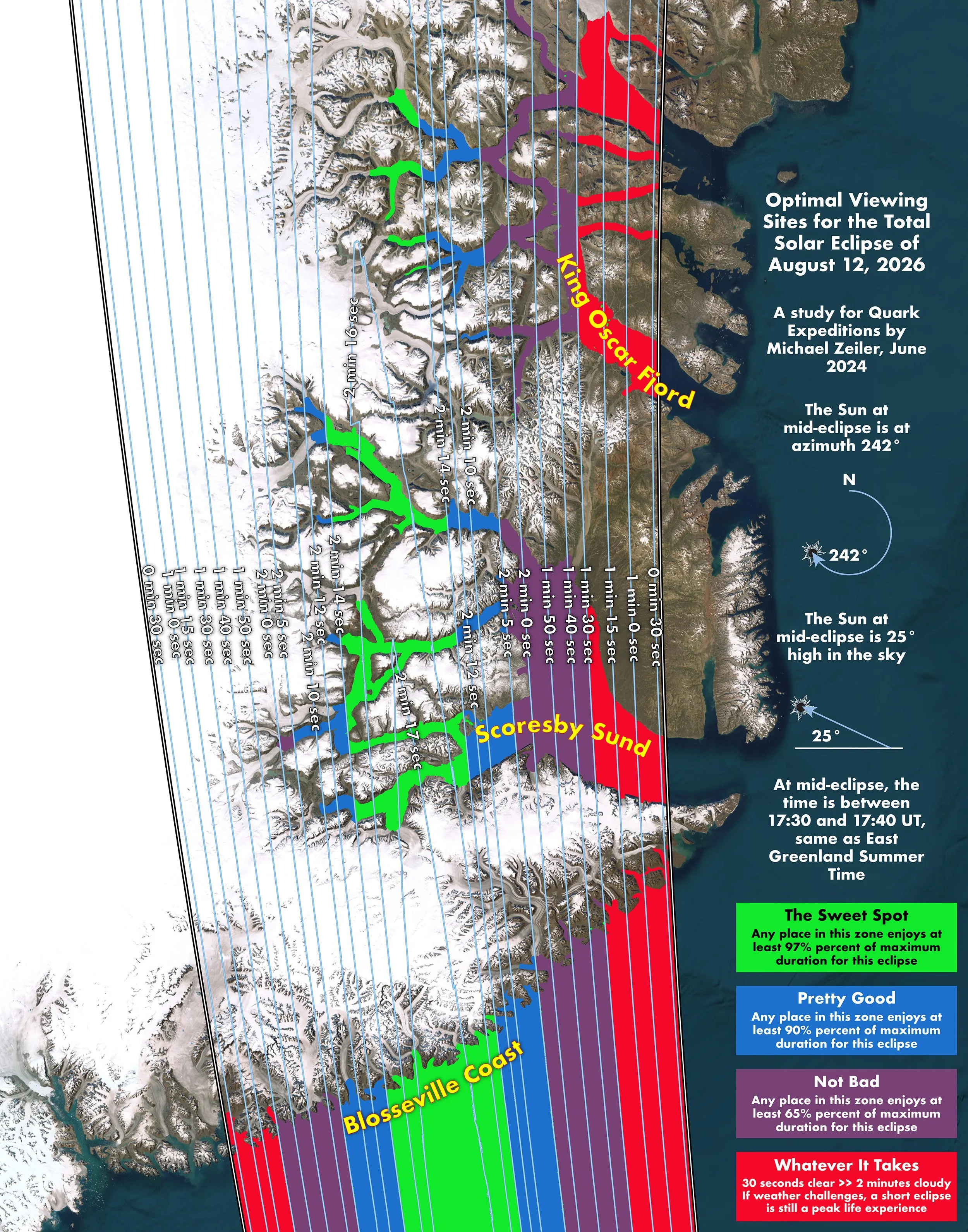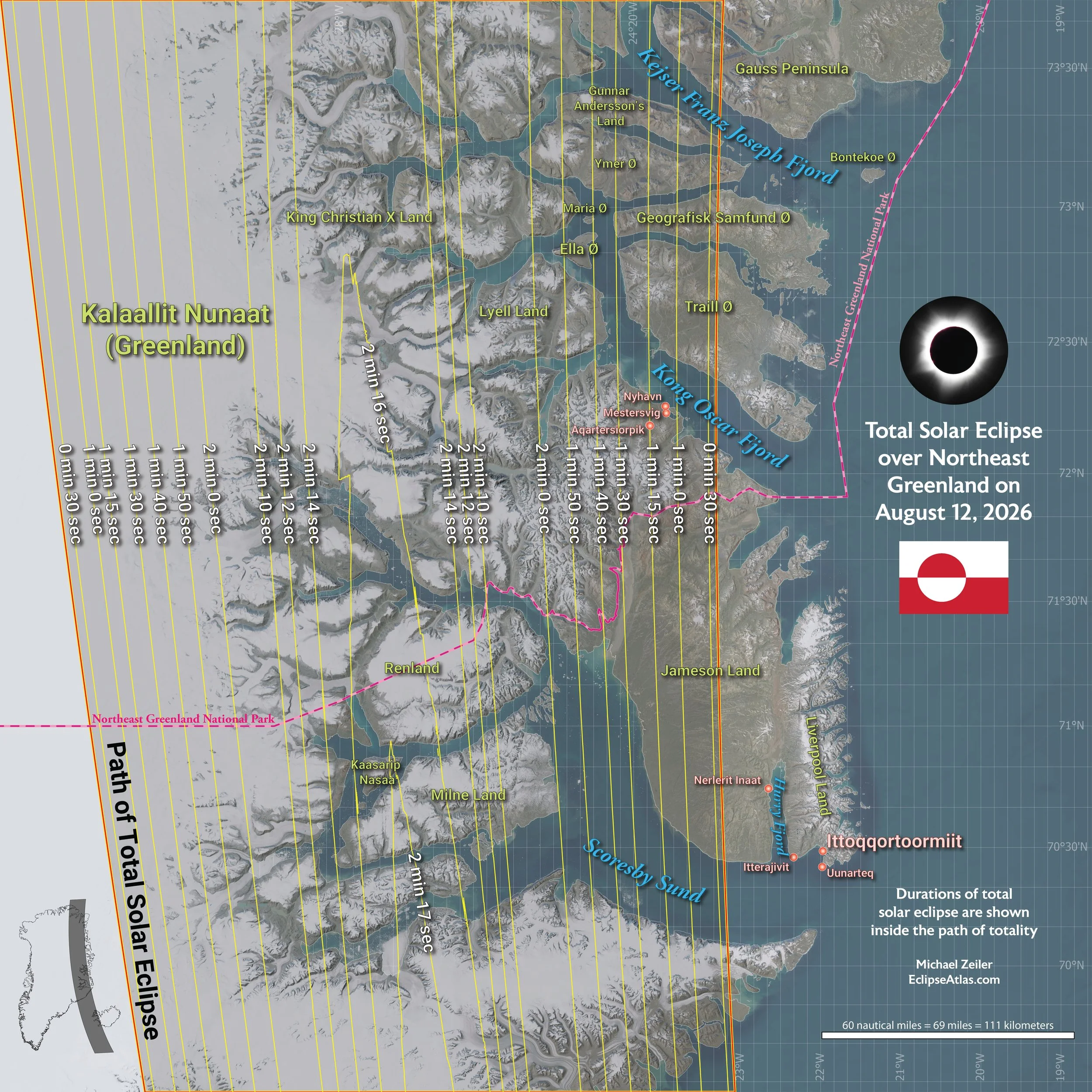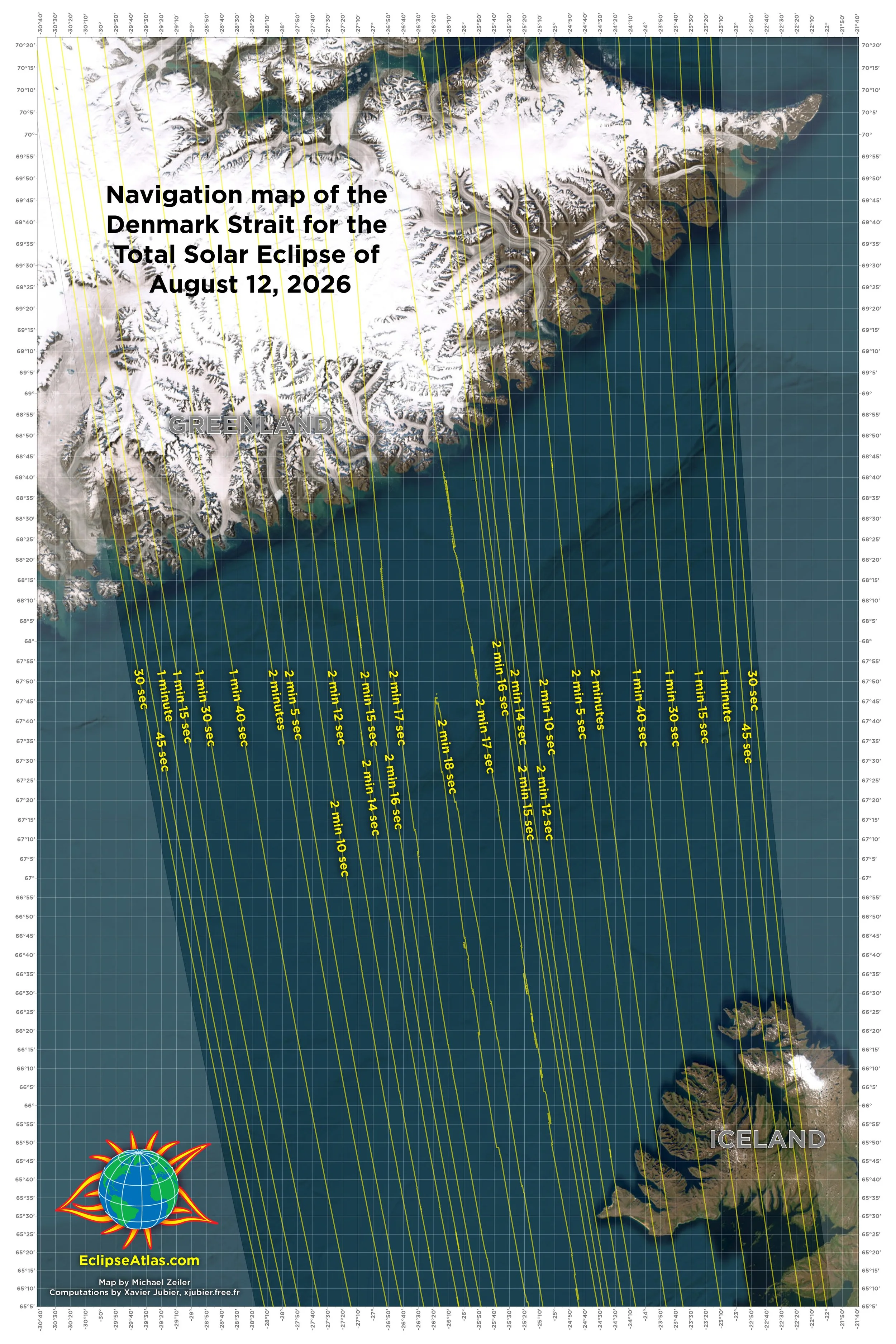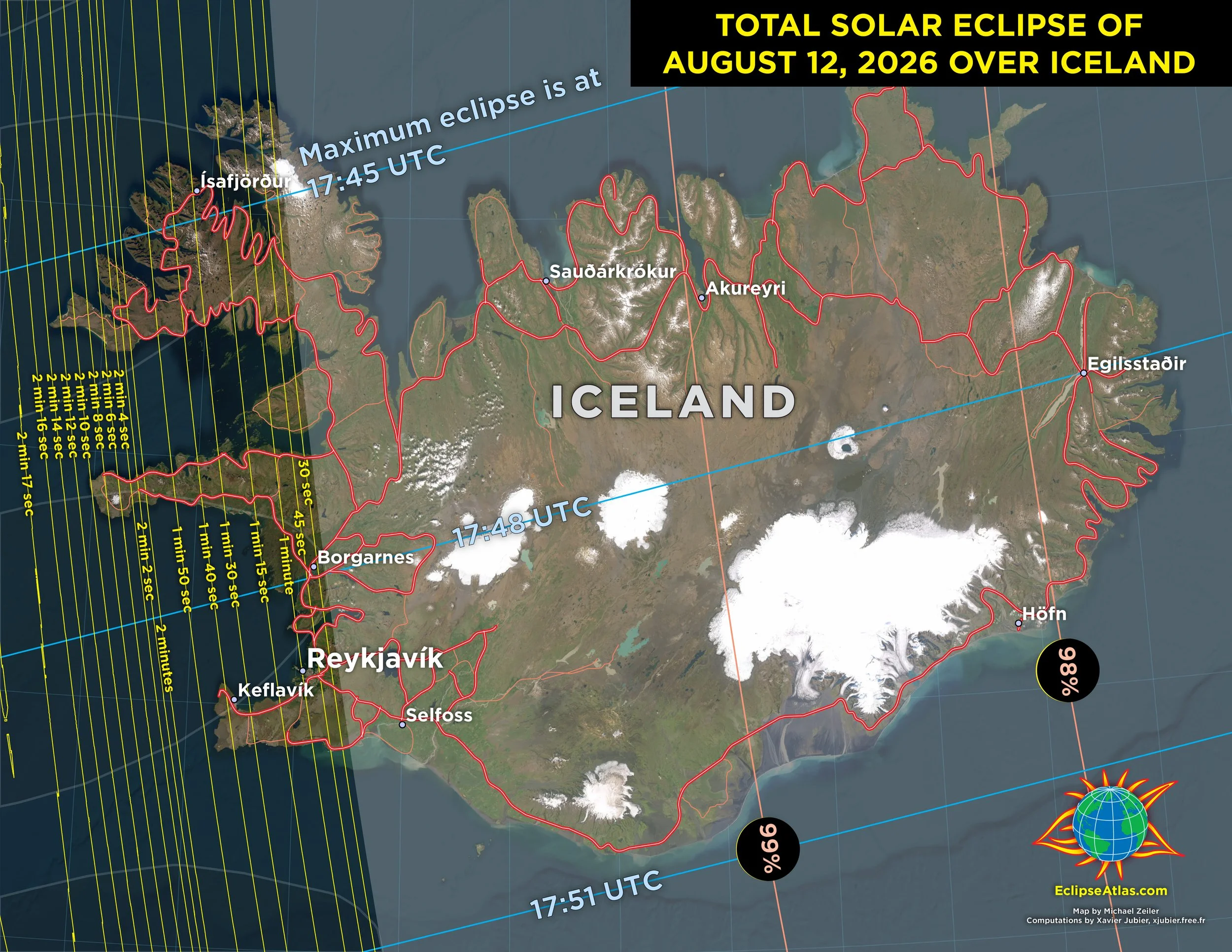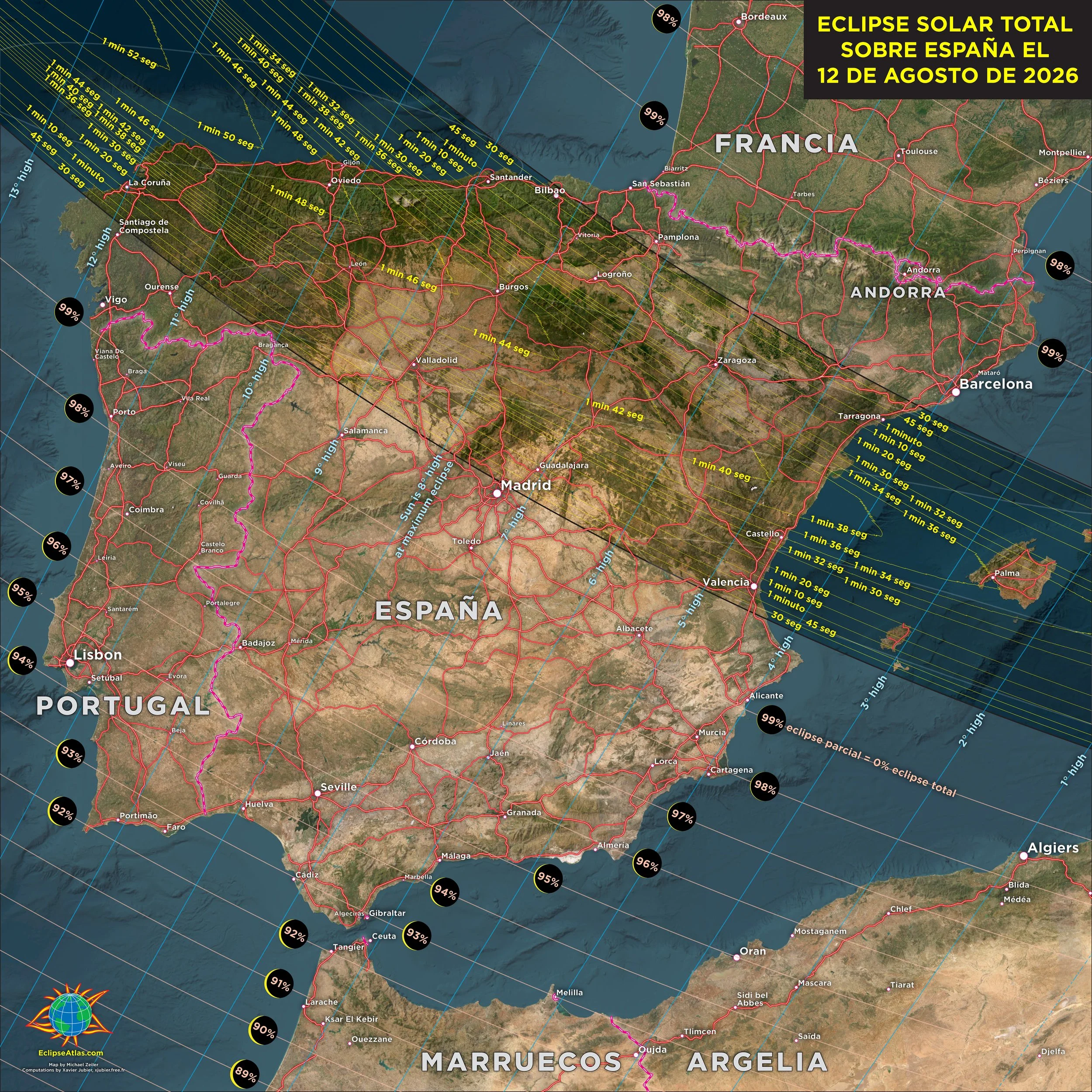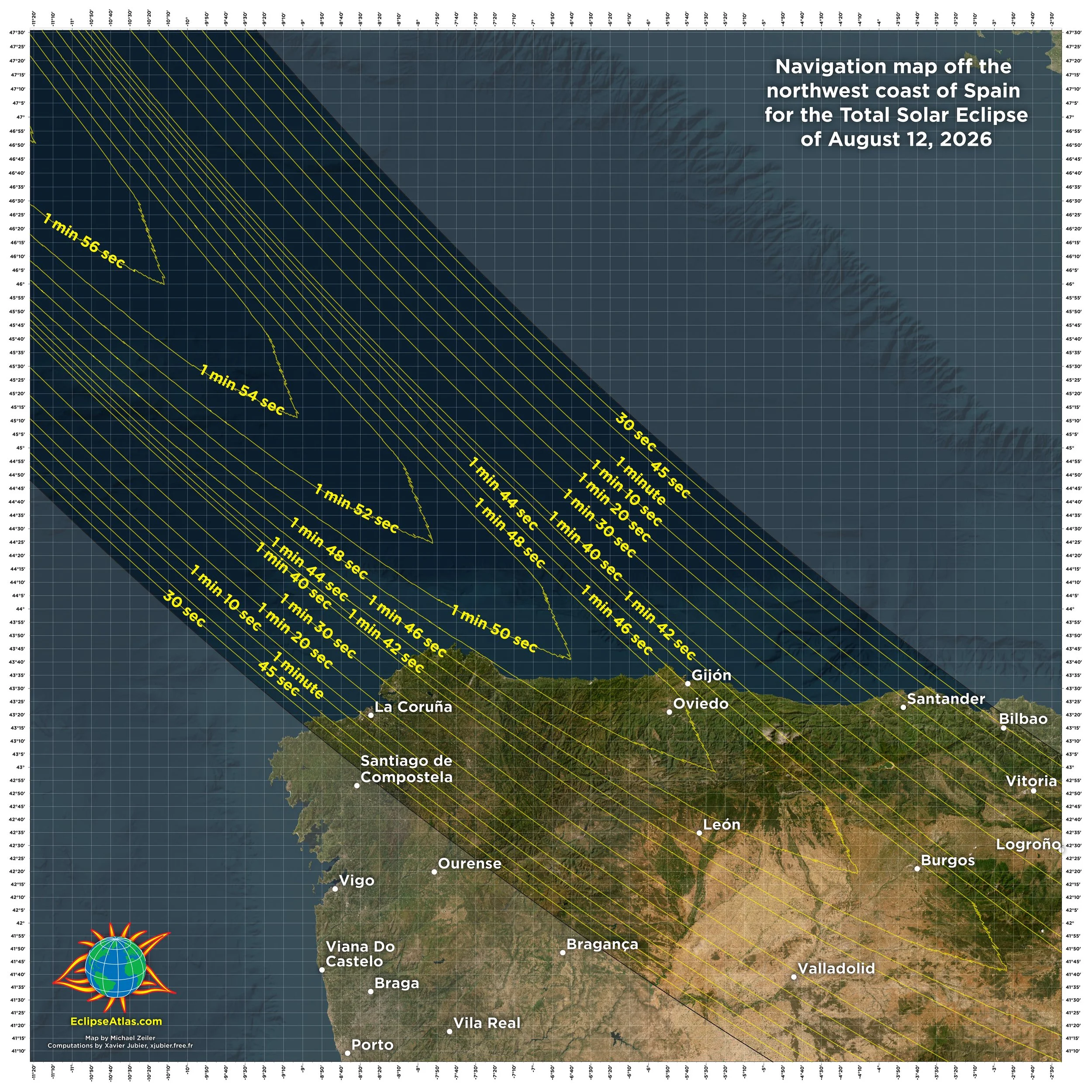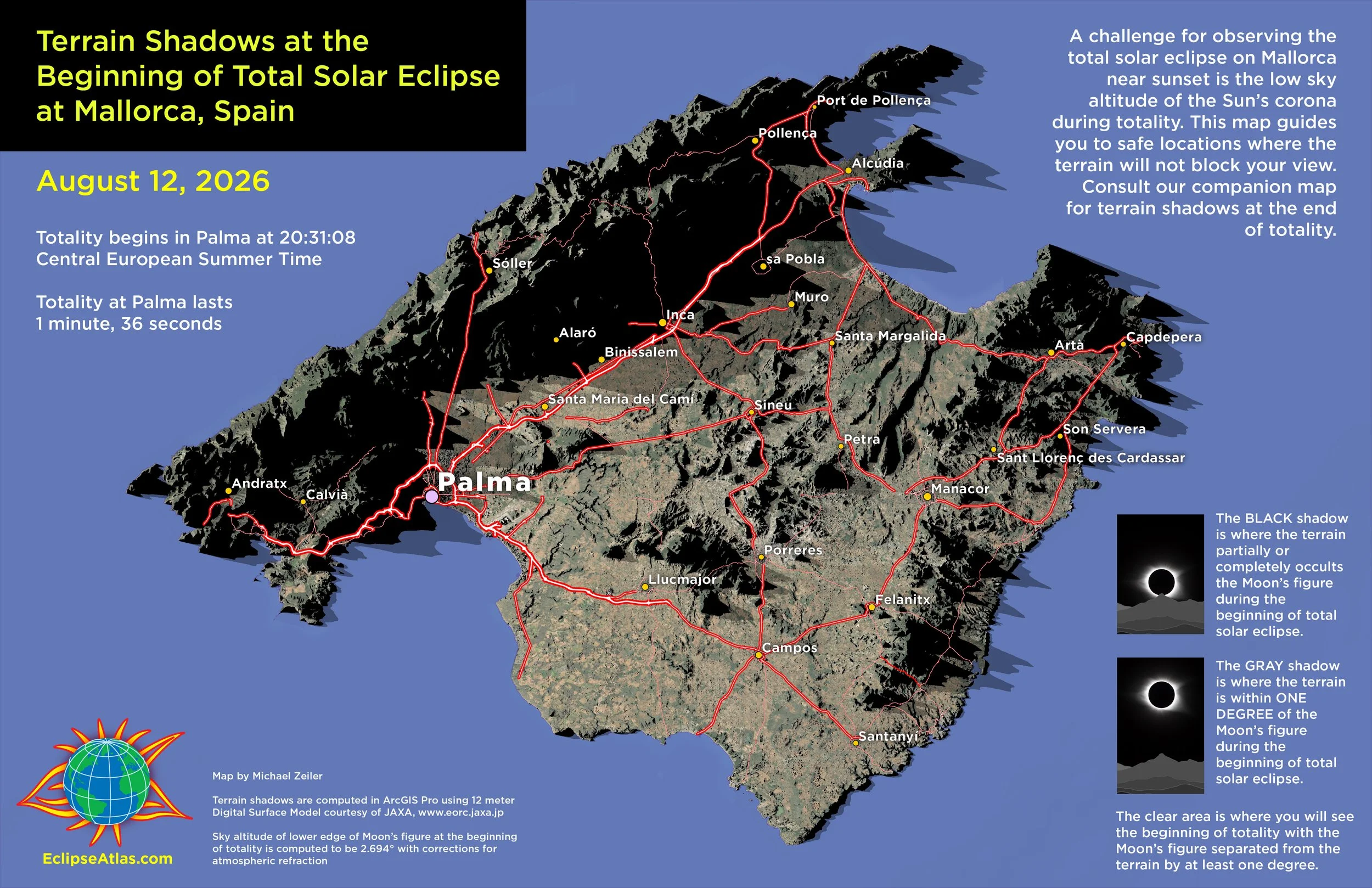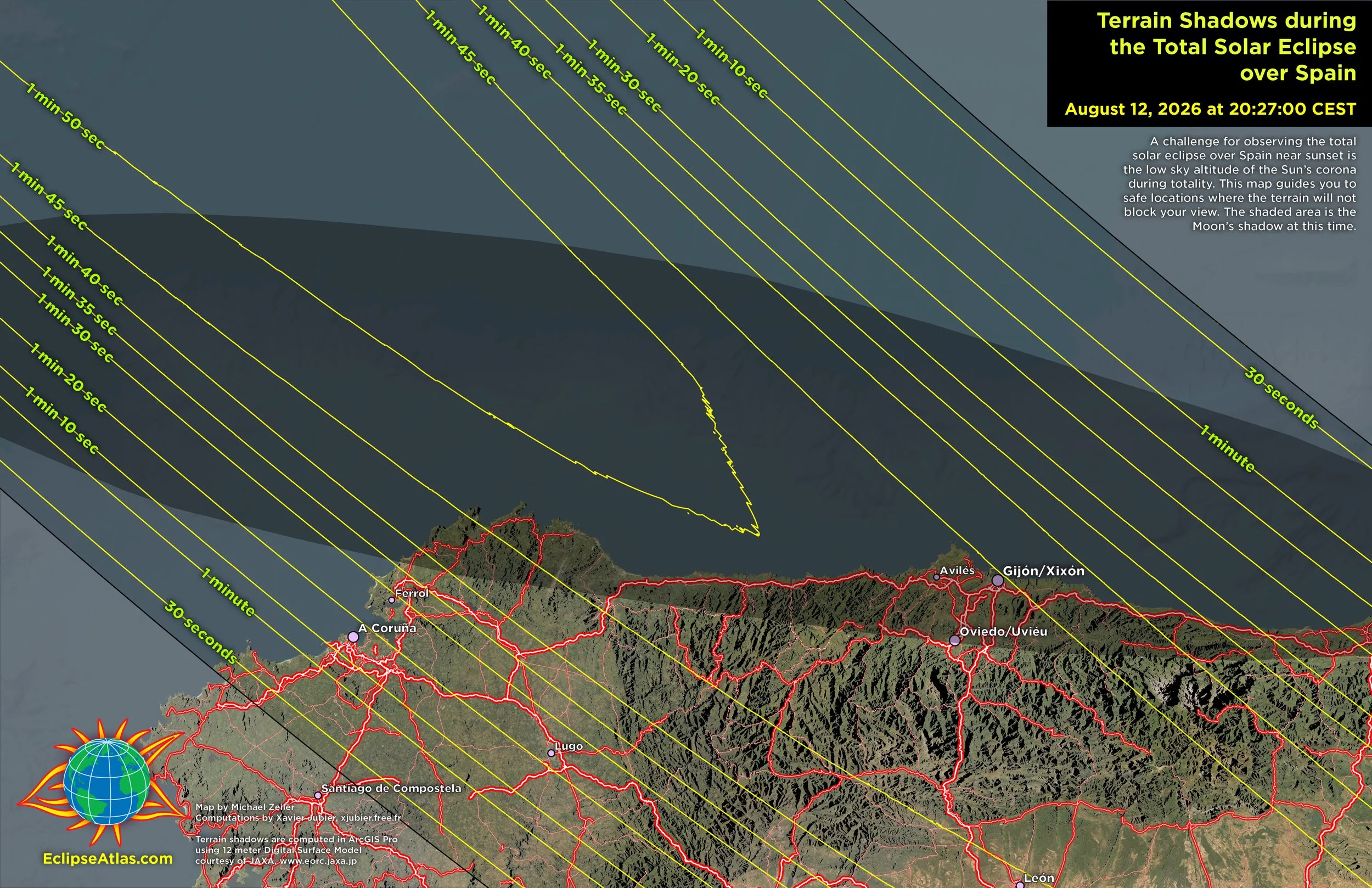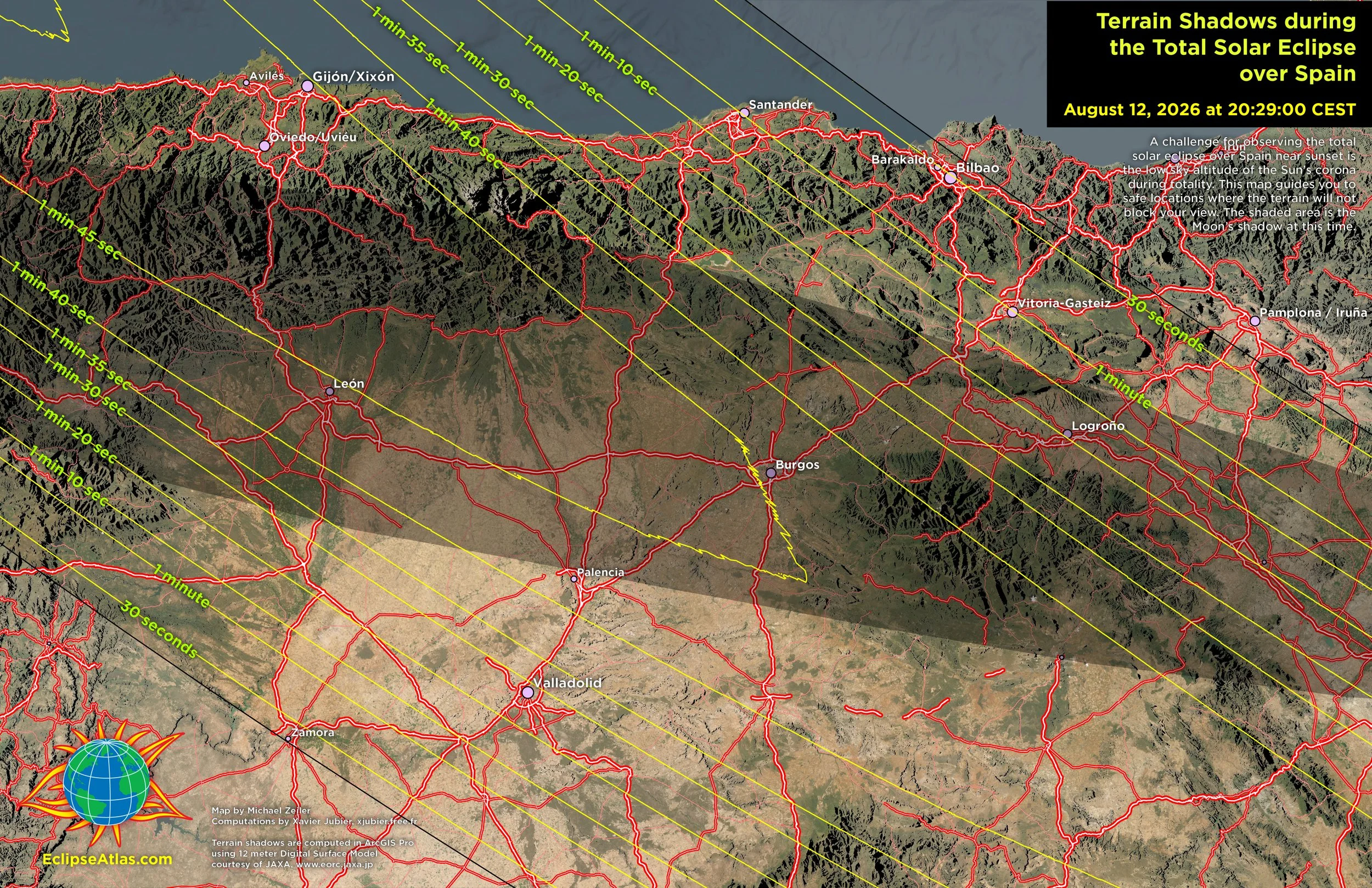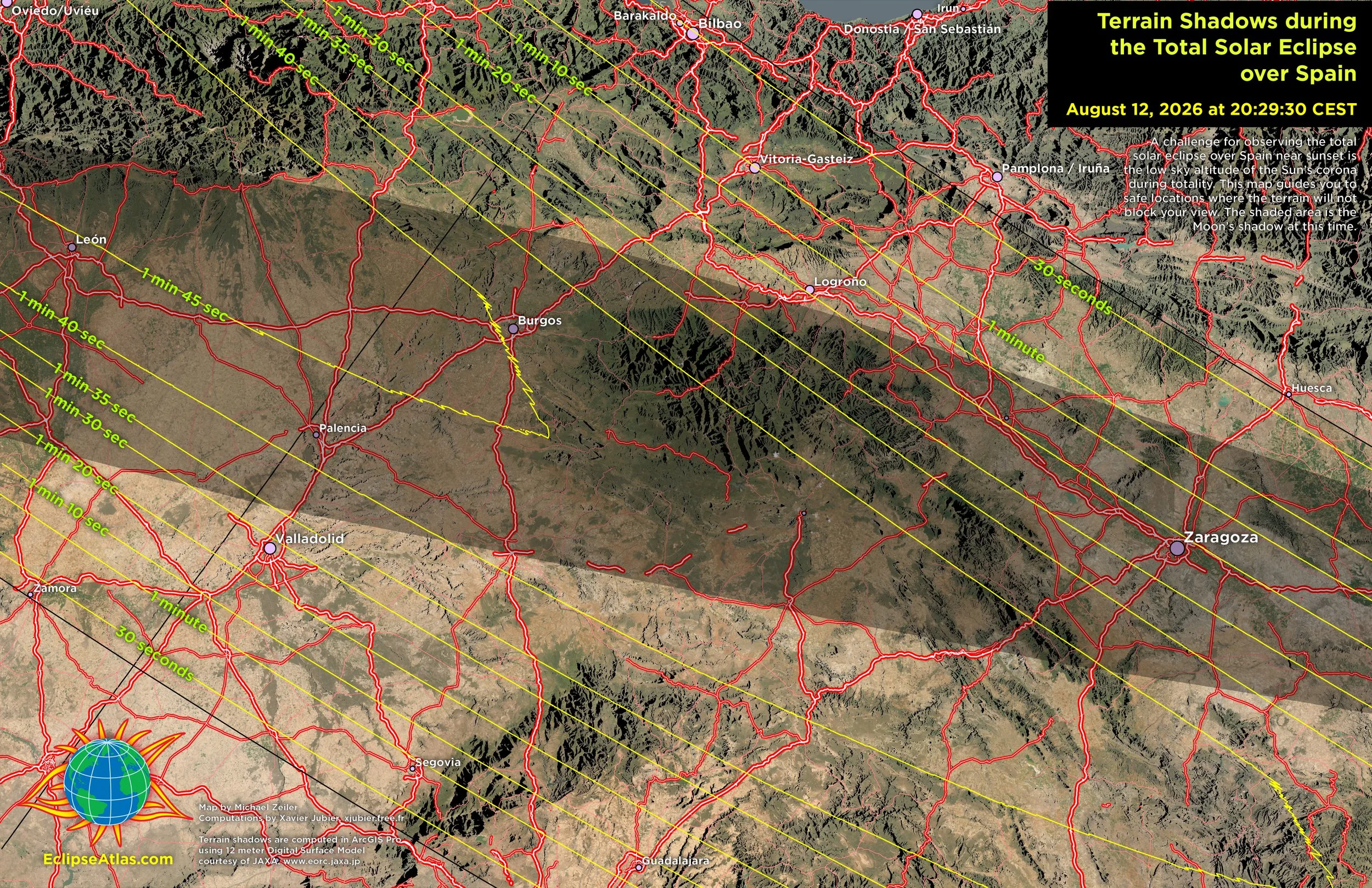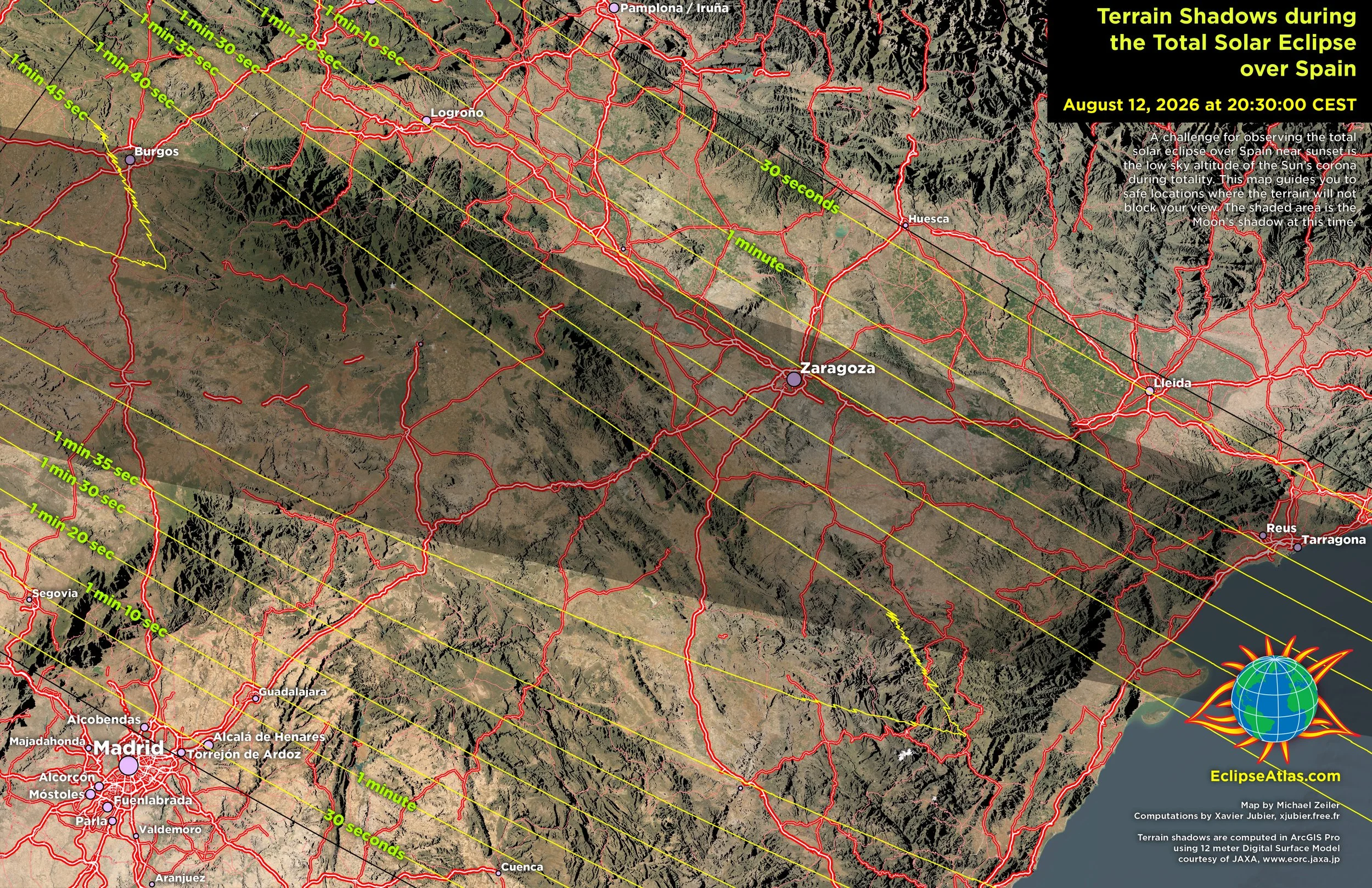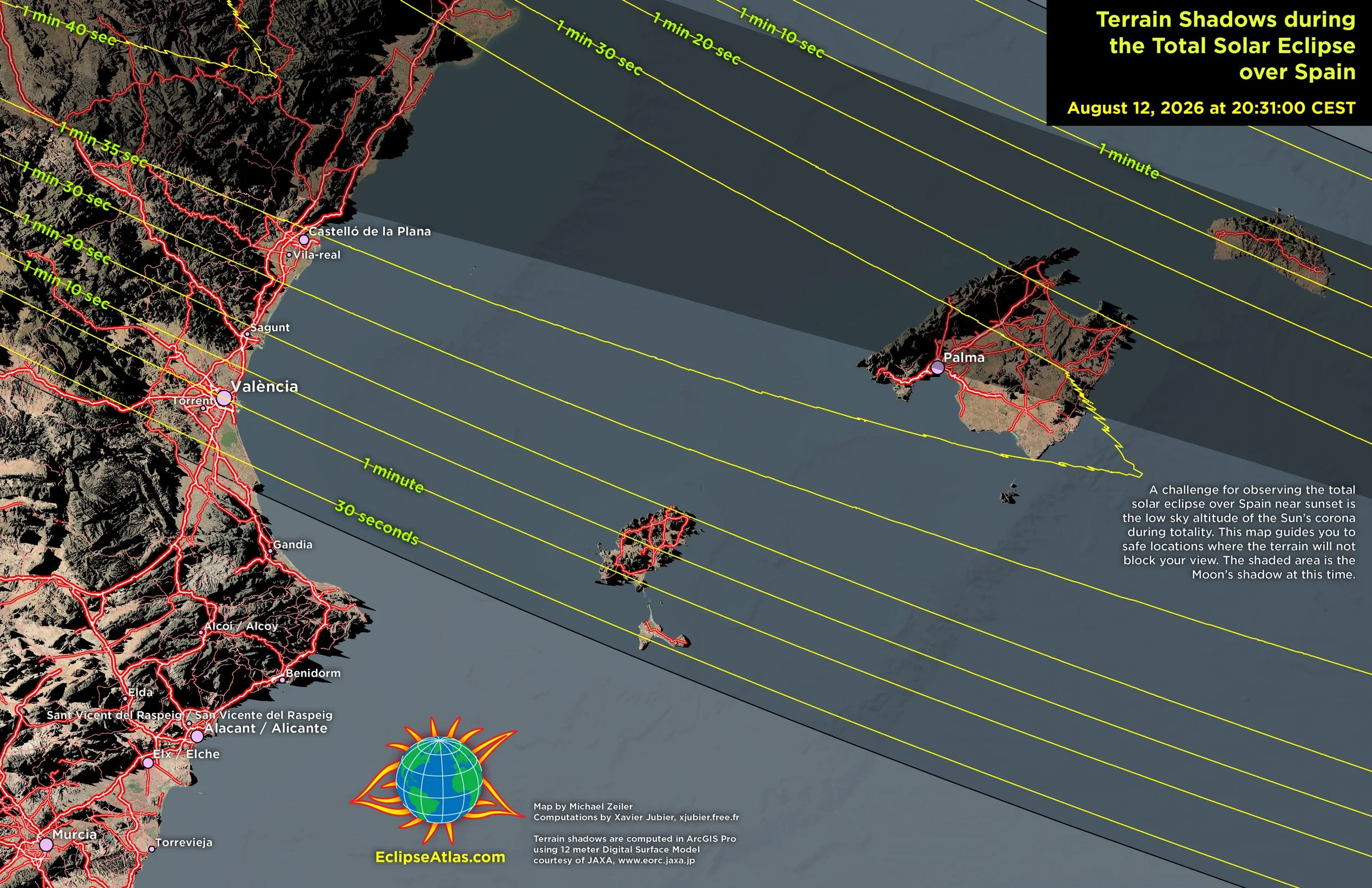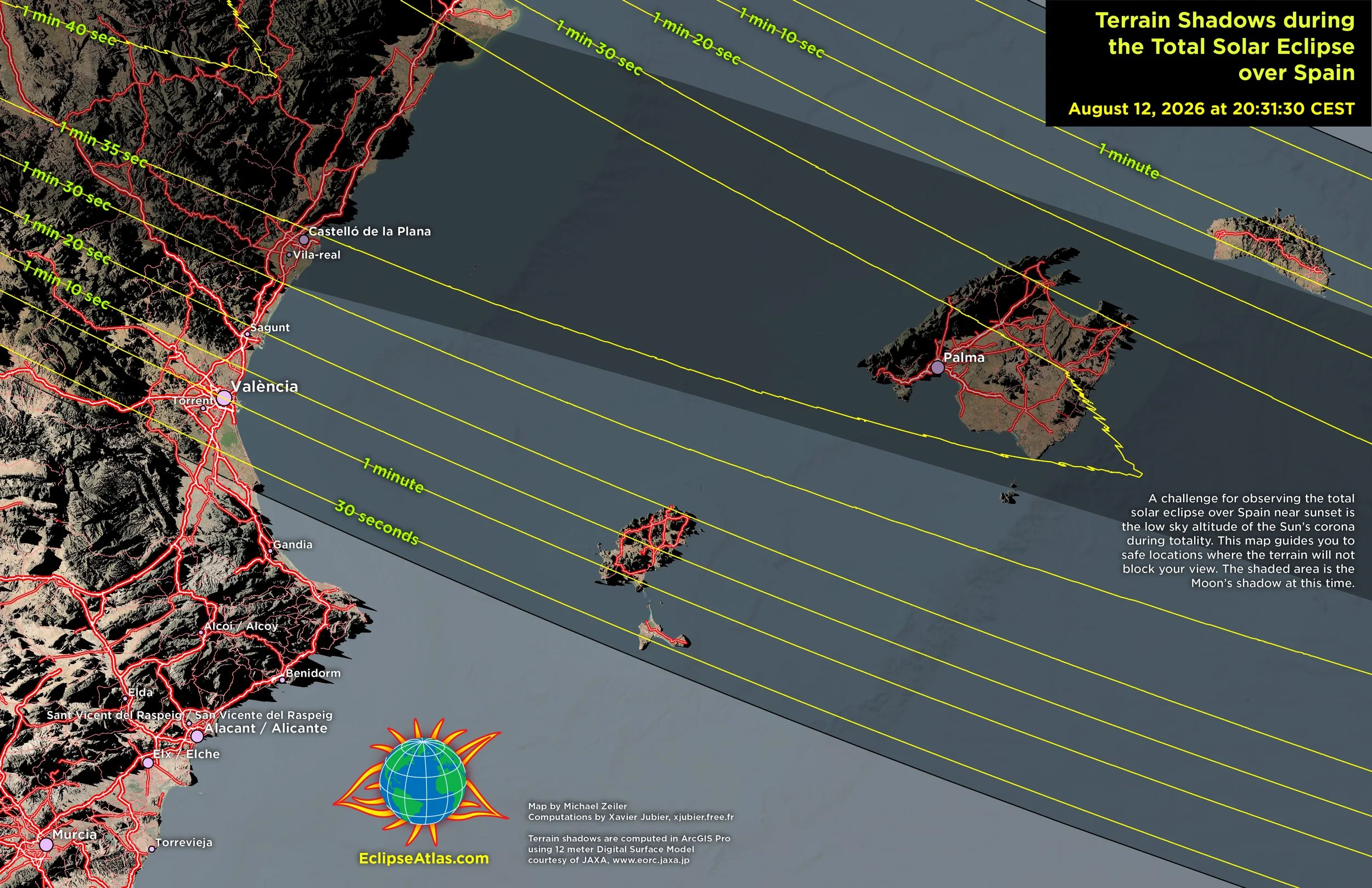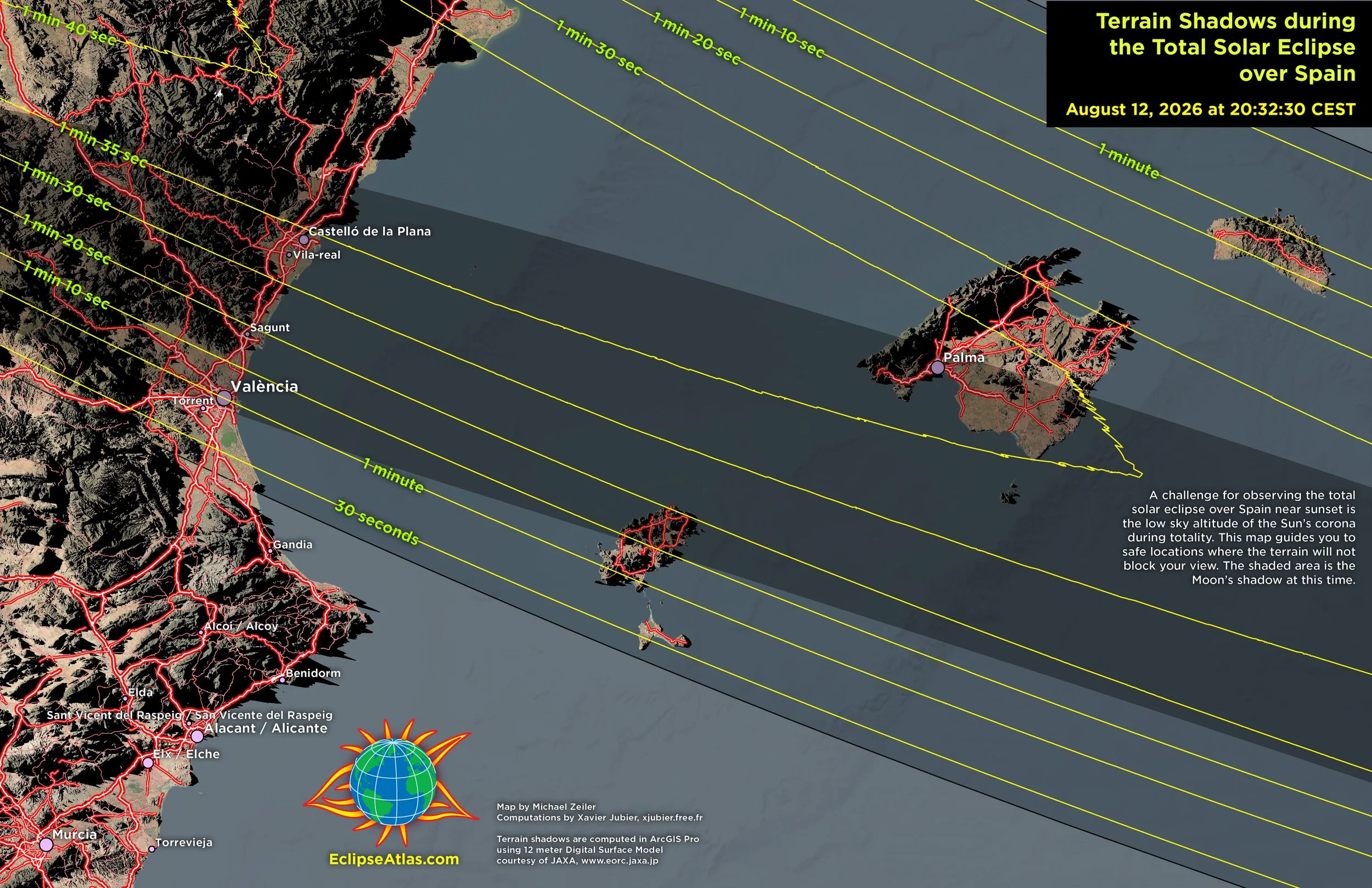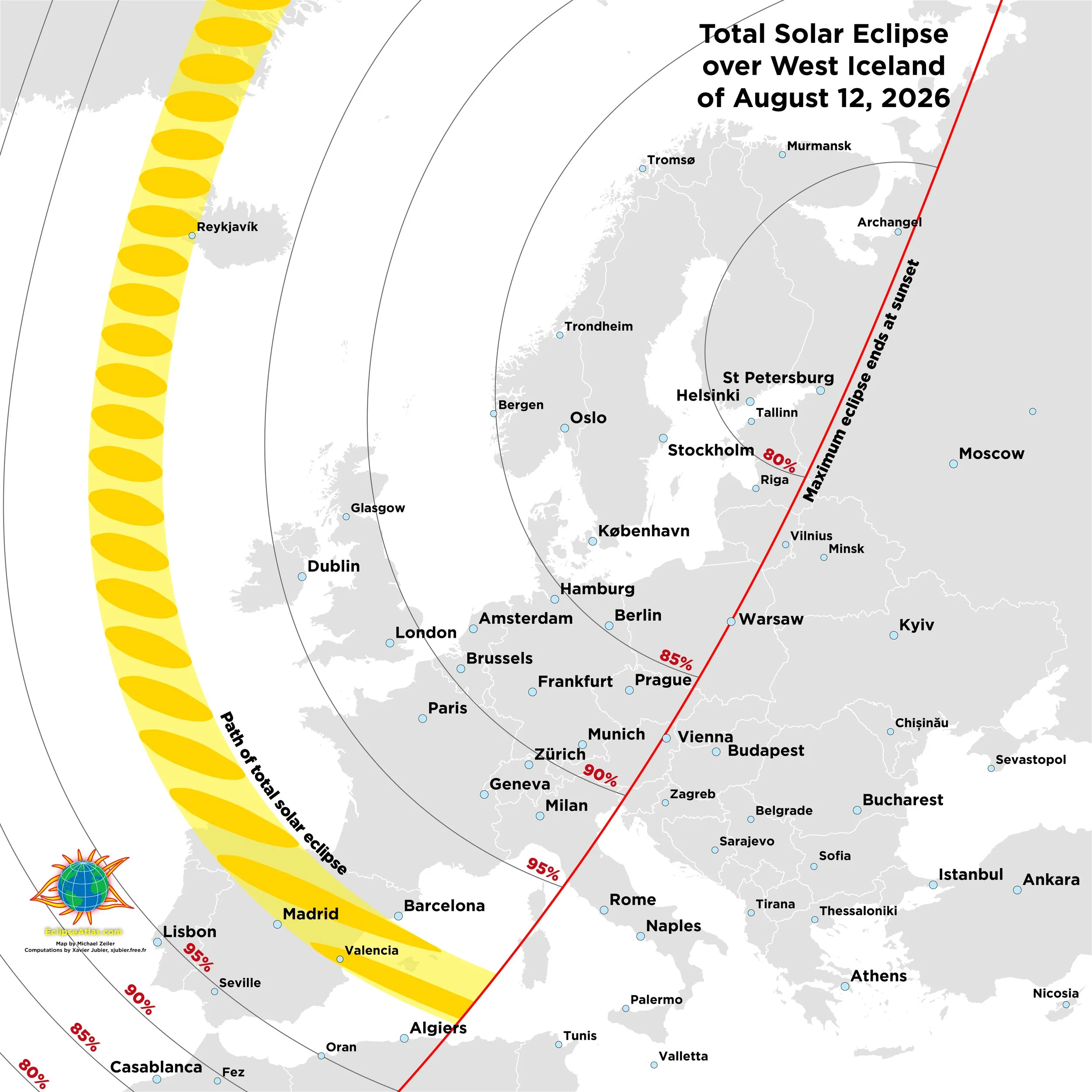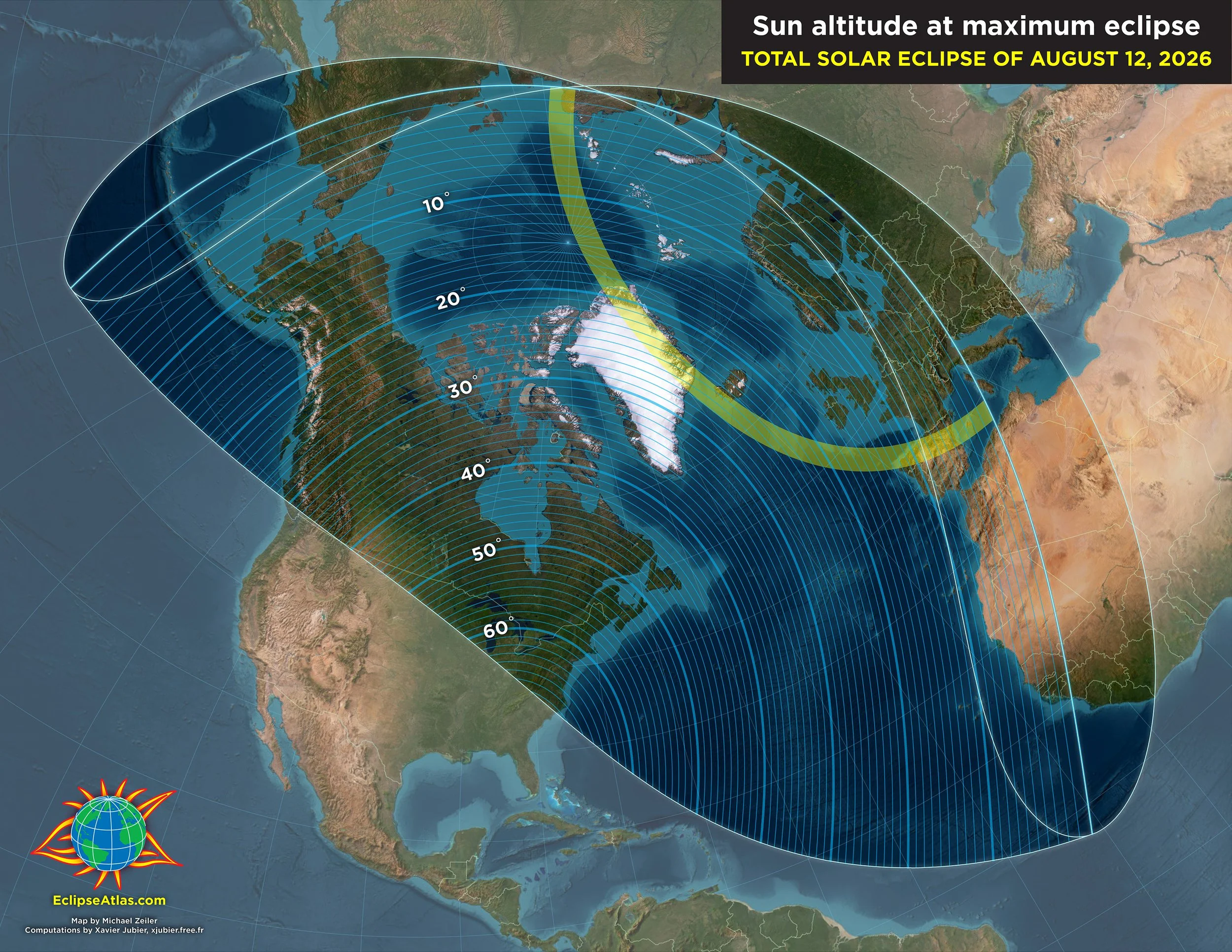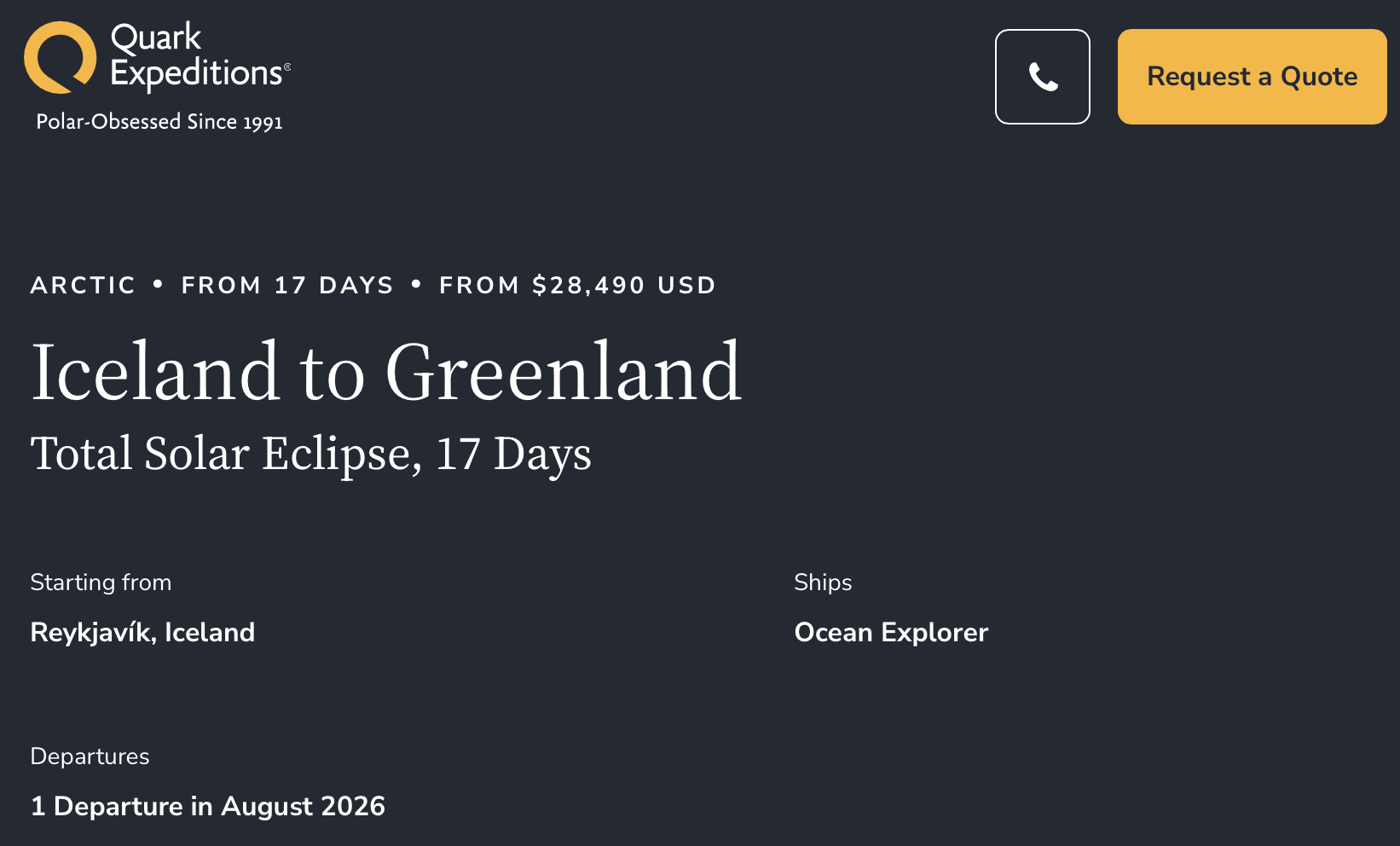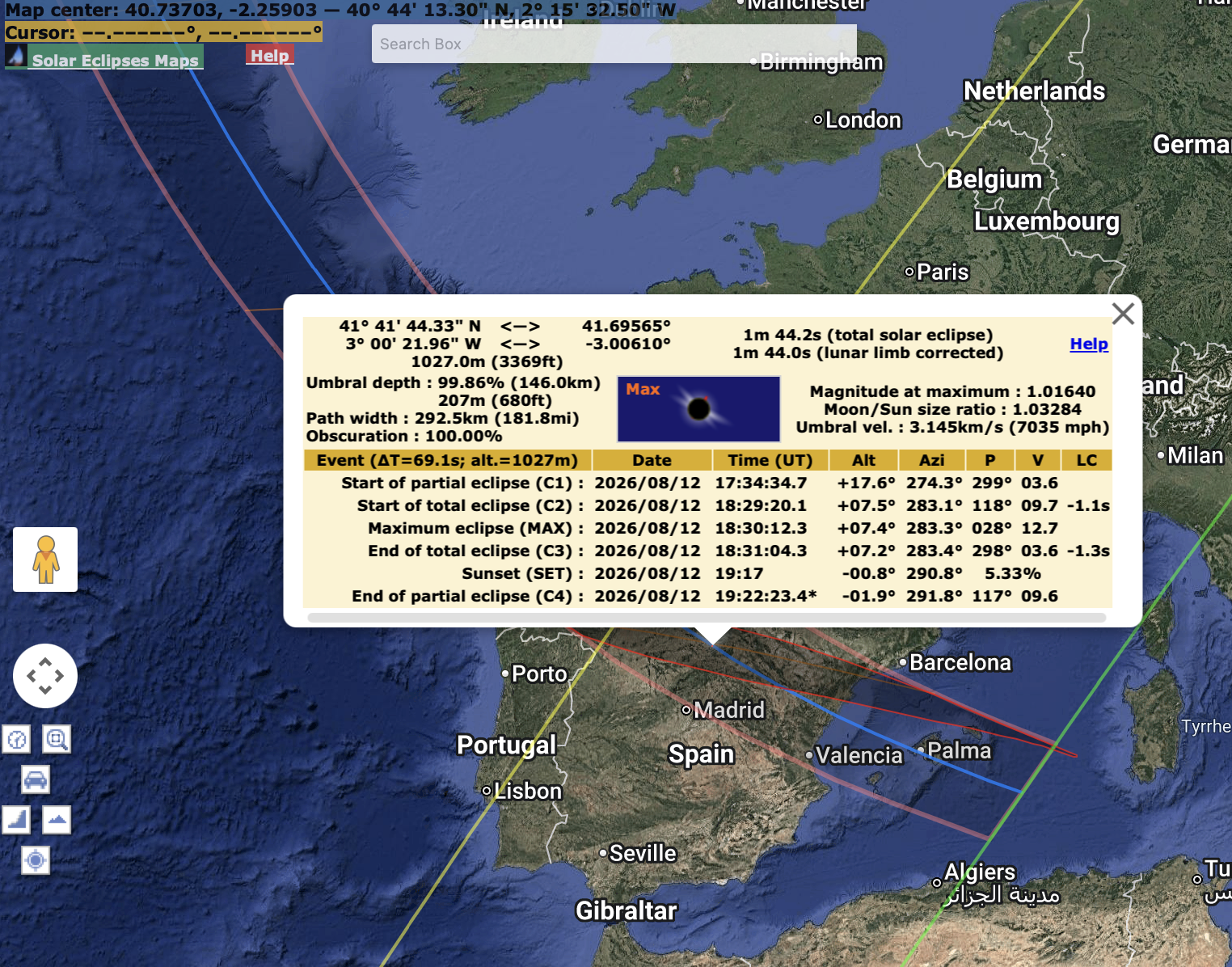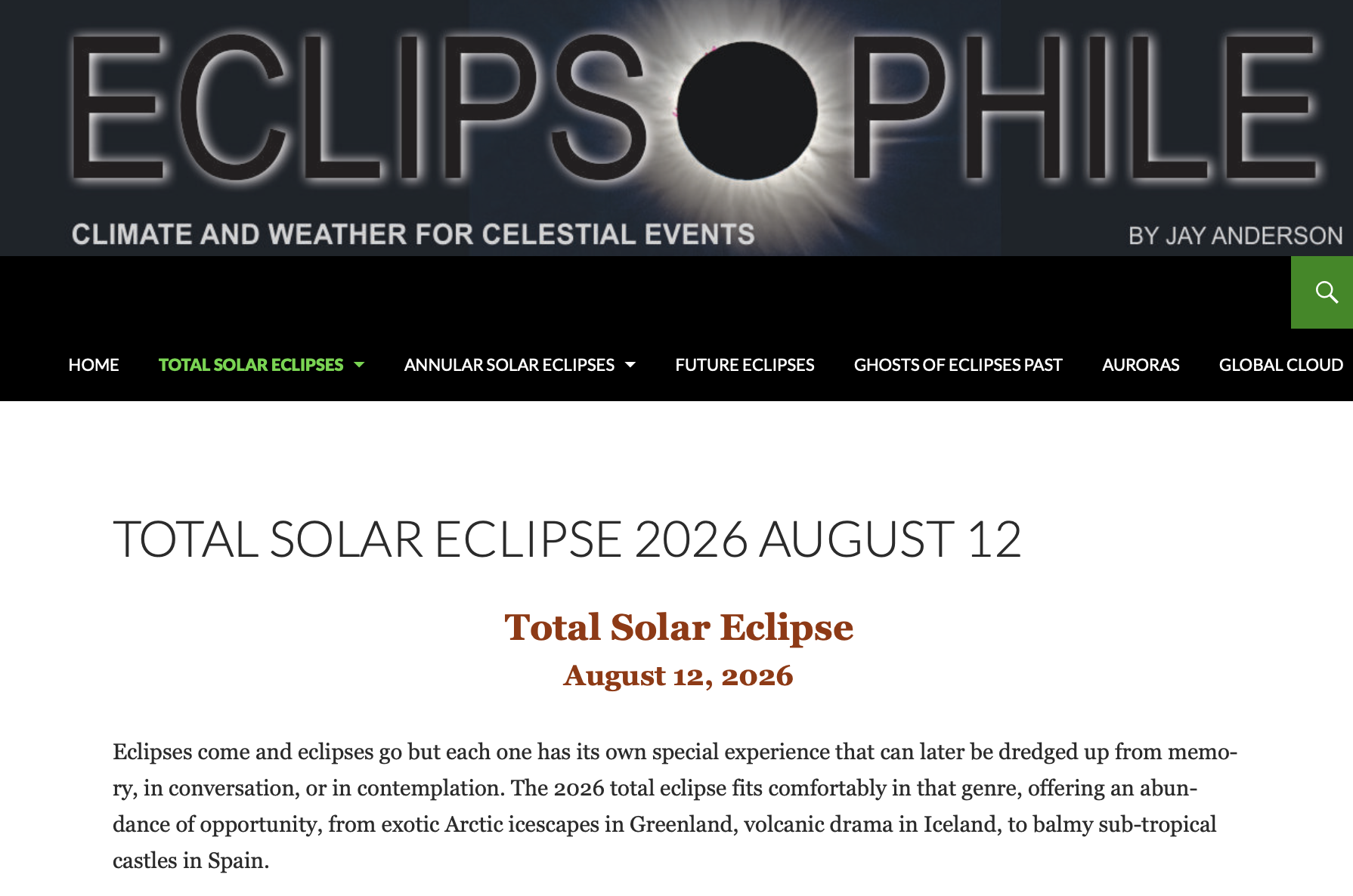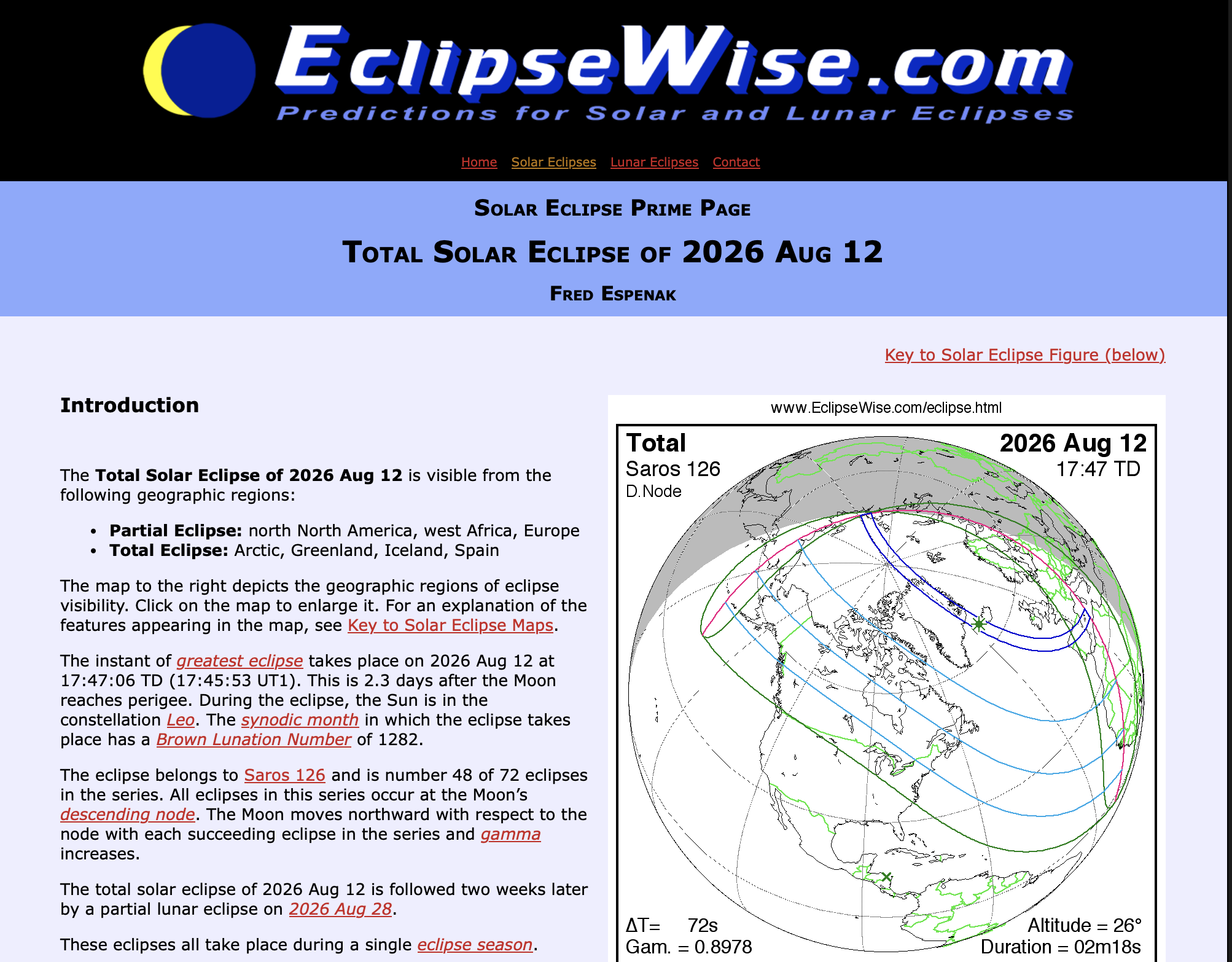Total Solar Eclipse of August 12, 2026
The total eclipse begins at sunrise in a remote area of northern Siberia. The path of totality sweeps over the Arctic icecap, coming within just one degree of the North Pole. The first landfall at Greenland comes at its northernmost tip and then crosses the Northeast Greenland National Park. The largest fjord in the world, Scoresby Sund, experiences up to 2 minutes and 16 seconds of totality. After crossing the Denmark Strait, totality covers western Iceland, including the capital Reykjavík. Shortly before ending at sunset, the total eclipse crosses northern Spain with a maximum duration of 1 minute and 49 seconds. The last landfall of totality is the Balearic Islands of Spain.
Total Solar Eclipse over East Greenland
While remote, the majestic fjords of northeast Greenland will be an attractive destination for eclipse tourists who can afford the expedition ships which will visit this area. Despite the cloudy conditions along much of the Greenland coast, the fjords have a micro-climate that may produce favorable conditions for viewing the eclipse. Katabatic winds form by the cooling of air above the Greenlandic icecap and the dense cold air falling down to the fjord has the beneficial effect of tending to clear the skies, yielding decent odds for success on eclipse day.
Total Solar Eclipse over Iceland
Totality visits the island nation of Iceland, including its capital Reykjavík. The Snæfellsnes Peninsula and the Westfjords are two of the most scenic regions of Iceland and also enjoy the longest duration of totality. An eclipse traveler could stay in Reykjavík and head early toward Keflavík, the Snæfellsnes, or the Westfjords depending on weather conditions expected on eclipse day. Or one could stay in Reykjavík to experience just over one minute of totality, enough to experience the peak life moment of witnessing the Sun’s corona.
Total Solar Eclipse over Spain
The majority of eclipse tourists will visit Spain on eclipse day due to the available visitor infrastructure and ease of access via the road network or airlines. There are many scenic locations to experience totality, but because the Sun is low in the sky during the total solar eclipse, take care to avoid obstructions from the local terrain or trees and buildings. The Balearic Islands will see an extremely low total eclipse, just 2 or 3 degrees above the horizon. This will be a unique and dramatic sight if weather cooperates.
Because the Moon’s shadow strikes the Earth at a low angle, the shadows in this animation are highly elongated.
The eclipse in motion
The animation shows the inner shadow (umbra) and outer shadow (penumbra) of the eclipse from the perspective of the Moon. The umbra is where the total solar eclipse will be seen. The penumbra is where a partial solar eclipse will be observed from North America, northeast Russia, northwest Africa, and much of Europe.
A careful look at this animation shows how the Earth’s axial tilt, the Moon’s orbital inclination, and the offset from Earth’s center (called gamma) combine to create this curved eclipse path of totality on Earth.
The eclipse in summary
The maximum duration of totality occurs within the red dot on the yellow path of totality near Iceland.
Eclipse magnitude is the fraction of the Moon’s apparent disk size compared to the Sun.
Eclipse gamma is the fraction of the how close the center of the Moon’s shadow passes to the center of Earth.
Learn about Saros 126 at www.eclipsewise.com/solar/SEsaros/SEsaros126.html
Totality over Greenland
The fjords of northeast Greenland will be the focus of eclipse expedition ships because of the magnificent scenery and a favorable micro-climate for clear skies on eclipse day.
Overview of the solar eclipse over Greenland and Iceland
Navigation map for use on ships in the fjords of northeast Greenland
Analysis of optimal ship siting for Greenland fjords prepared for Quark Expeditions. Michael Zeiler will be the eclipse lecturer on the Ocean Explorer. For information, see the link at the bottom of this page.
Detail map of Scoresby Sund and Kong Oscar Fjord
Overview of Siberia and Greenland. From the Atlas of Solar Eclipses - 2020 to 2045 by Michael Zeiler and Michael Bakich
Navigation map designed for the use on ships in the Denmark Strait
Totality over Iceland
Iceland is a popular tourist destination and the scenic western peninsulas will host many eclipse visitors.
Overview of the eclipse over Iceland
Detail map of the eclipse over west Iceland
Overview map of the eclipse over Iceland From the Atlas of Solar Eclipses - 2020 to 2045 by Michael Zeiler and Michael Bakich
Totality over Spain
Spain will attract the greatest number of eclipse visitors due to easy access from the European road network and major airports.
Overview map of the eclipse over Spain
Overview map of Spain en Español
Navigation map for ships off the northwest coast of Spain
Navigation map for ships in the Mediterranean
Overview map of the eclipse over Spain From the Atlas of Solar Eclipses - 2020 to 2045 by Michael Zeiler and Michael Bakich
Terrain shadows over Spain
A special challenge for the eclipse in Spain will be the low Sun altitude in the sky during totality. These maps guide you to where you can view the total eclipse without obscuration by the local terrain.
Terrain shadows at the beginning of eclipse, Mallorca
Terrain shadows at the end of eclipse, Mallorca
Terrain shadows over Spain, 18:27:00 CEST
Terrain shadows over Spain, 18:27:30 CEST
Terrain shadows over Spain, 18:28:00 CEST
Terrain shadows over Spain, 18:28:30 CEST
Terrain shadows over Spain, 18:29:00 CEST
Terrain shadows over Spain, 18:29:30 CEST
Terrain shadows over Spain, 18:30:00 CEST
Terrain shadows over Spain, 18:30:30 CEST
Terrain shadows over Spain, 18:31:00 CEST
Terrain shadows over Spain, 18:31:30 CEST
Terrain shadows over Spain, 18:32:00 CEST
Terrain shadows over Spain, 18:32:30 CEST
Terrain shadows over Spain, 18:33:00 CEST
Terrain shadows over Spain, 18:33:30 CEST
Overview of the August 12, 2026 total solar eclipse
Partial solar eclipse over Europe
Eclipse overview From the Atlas of Solar Eclipses by Michael Zeiler and Michael Bakich
Orthographic view of the eclipse From the Atlas of Solar Eclipses - 2020 to 2045 by Michael Zeiler and Michael Bakich
Circumstances of the eclipse
These maps give the maximum eclipse obscuration, times of beginning, mid-eclipse, and end, and sun altitude at beginning, mid-eclipse, and end.
Maximum eclipse obscuration
Time when eclipse begins
Time of maximum eclipse
Time when eclipse ends
Sun altitude when eclipse begins
Sun altitude at maximum eclipse
Sun altitude when eclipse ends
Resources for the total solar eclipse of August 12, 2026
Quark Expeditions Michael Zeiler of EclipseAtlas.com will be the eclipse lecturer on an eclipse cruise to Greenland! Another Quark ship will have eclipse historian David Baron as a lecturer.
Eclipse2026.is Eclipse travelers to Iceland will find local insights and information here

Eclipse262728.es Spain gets two total and one annular solar eclipses in the next three years. Find local information here. With Spanish and English pages
xjubier.free.fr Every eclipse chaser uses this essential website for detailed eclipse planning.
Eclipsophile.com Jay Anderson, meteorologist and eclipse chasers, gives comprehensive meteorological analysis to improve your odds on eclipse day
BesselianElements.com This team provides extremely accurate eclipse maps and performs scientific studies at every eclipse
eclipsewise.com This page by Fred Espenak provides detailed information on this and many other eclipses

